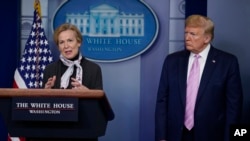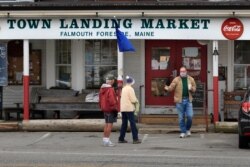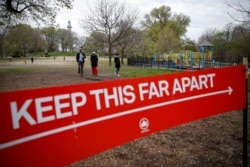The White House is targeting nine U.S. states that have recorded the fewest number of confirmed coronavirus cases to be among the first to reopen their economies.
Dr. Deborah Birx, the White House virus task force coordinator, said Wednesday night that the nine states all have fewer than 1,000 confirmed cases of the coronavirus and are recording fewer than 30 new cases a day.
The coronavirus has ravaged the United States and wreaked havoc with its economy, leading to more than 22 million layoffs of workers in the last four weeks.
President Donald Trump is pushing to reopen the country’s world-leading economy as quickly as possible, with May 1 his target date for parts of the country that have not sustained the impact from the coronavirus as the hardest hit regions, such as the New York metropolitan area.
Birx did not name the nine states, but her reference to the number of coronavirus cases appears to identify the states as among the least populated in the country, extending from the Atlantic coastal state of Maine to the Pacific island state of Hawaii. The seven others are Vermont and West Virginia in the eastern U.S., Arkansas in the southern part of the country, Nebraska and North Dakota in the Midwest and Montana and Wyoming in the West.
Perhaps the key reason why these states have had relatively few coronavirus cases is that they are among the 19 of the 50 states with the fewest number of people.
As such, people on the whole do not live in as close proximity to each other as is the case in major cities across the country and therefore the chances for person-to-person passage of the coronavirus are diminished.
The nine states collectively have only five cities that are among the 300 biggest in the U.S.
While reopening the economy anywhere in the U.S. would be a start to a return to some sense of normalcy in the country, the nine states by themselves, because of their small size, comprise a very modest part of the U.S. economy.
Birx says that governors and mayors would decide on lifting coronavirus restrictions after the federal government gives its guidance on Thursday.
Trump said that governors, whom he did not name, were “chomping at the bit to get going.” He is talking with them on a Thursday conference call.
Despite Trump’s push to restart the U.S. economy, Birx warned Americans that they cannot yet ease off on social distancing, the government’s recommendation to stay apart from other people by at least two meters.
“I will remind the people again: This is a highly contagious virus,” she said. “Social gatherings, coming together — there is a chance an asymptomatic person can spread it unknowingly. Don’t have that dinner party for 20 yet.”
Earlier, she told “The View” television show that communities with widespread testing capacity and few confirmed coronavirus cases may be able to begin easing some of their restrictions.
“So, when you look at that you can see states that have good surveillance up and running right now where they haven’t really seen significant increases in cases,” she said. “And so this has got to be done in a very laser-focused, data-driven manner. But as the data comes in, I think we’re really confident that we can actually see places that could do very well with some decreasing restrictions.”
A draft plan by the Centers for Disease Control and Prevention and the Federal Emergency Management Agency lays out a way for the country to reopen. But it spells out several conditions, including “steadily decreasing infections” and a “public health system capacity for case identification and rapid containment” if conditions worsen.
“Lifting stay-at-home orders carefully, on a community by community basis, only when ready, will help extend the gains made from this time of collective social distancing,” the draft document states. “Coming out of mitigation in a controlled way, with robust monitoring systems in place to contain new cases and outbreaks will be critical to navigating the next phase of this pandemic.”









